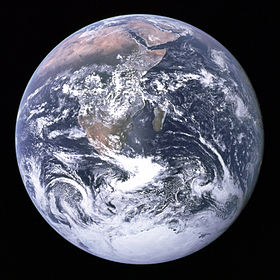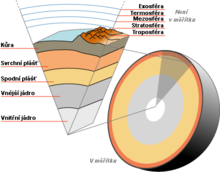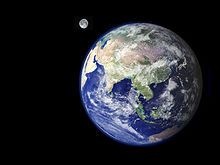solar System
HOME
Mercury VenusEarth
Mars
Galerie Extra
 |
 |
 |
Earth
Earth, also called the world and, less frequently, Gaia, (or Terra in some works of science fiction) is the third planet from the Sun, the densest planet in the Solar System, the largest of the Solar System's four terrestrial planets and the only astronomical object known to accommodate life. The earliest life on Earth arose at least 3.5 billion years ago. Earth's biodiversity has expanded continually except when interrupted by mass extinctions. Although scholars estimate that over 99 percent of all species that ever lived on the planet are extinct, Earth is currently home to 10–14 million species of life, including over 7.2 billion humans who depend upon its biosphere and minerals. Earth's human population is divided among about two hundred sovereign states which interact through diplomacy, conflict, travel, trade and communication media.

According to evidence from radiometric dating and other sources, Earth was formed around four and a half billion years ago. Within its first billion years, life appeared in its oceans and began to affect its atmosphere and surface, promoting the proliferation of aerobic as well as anaerobic organisms and causing the formation of the atmosphere's ozone layer. This layer and the geomagnetic field blocked the most life-threatening parts of the Sun's radiation, so life was able to flourish on land as well as in water. Since then, the combination of Earth's distance from the Sun, its physical properties and its geological history have allowed life to persist.
Earth's lithosphere is divided into several rigid tectonic plates that migrate across the surface over periods of many millions of years. Seventy-one percent of Earth's surface is covered with water, with the remainder consisting of continents and islands that together have many lakes and other sources of water that contribute to the hydrosphere. Earth's poles are mostly covered with ice that includes the solid ice of the Antarctic ice sheet and the sea ice of the polar ice packs. Earth's interior remains active with a solid iron inner core, a liquid outer core that generates the magnetic field, and a thick layer of relatively solid mantle.

Earth gravitationally interacts with other objects in space, especially the Sun and the Moon. During one orbit around the Sun, Earth rotates about its own axis 366.26 times, creating 365.26 solar days or one sidereal year. Earth's axis of rotation is tilted 23.4° away from the perpendicular of its orbital plane, producing seasonal variations on the planet's surface with a period of one tropical year (365.24 solar days). The Moon is Earth's only natural satellite. It began orbiting Earth about 4.53 billion years ago. The Moon's gravitational interaction with Earth stimulates ocean tides, stabilizes the axial tilt and gradually slows the planet's rotation.
Name and etymology
The modern English word Earth developed from a wide variety of Middle English forms, which derived from an Old English noun most often spelled eor?e. It has cognates in every Germanic language, and their proto-Germanic root has been reconstructed as *er?o. In its earliest appearances, eor?e was already being used to translate the many senses of Latin terra and Greek ?? (ge): the ground, its soil, dry land, the human world, the surface of the world (including the sea), and the globe itself. As with Terra and Gaia, Earth was a personified goddess in Germanic paganism: the Angles were listed by Tacitus as among the devotees of Nerthus, and later Norse mythology included Jör?, a giantess often given as the mother of Thor.
Originally, earth was written in lowercase and, from early Middle English, its definite sense as "the globe" was expressed as the earth. By early Modern English, many nouns were capitalized and the earth became (and often remained) the Earth, particularly when referenced along with other heavenly bodies. More recently, the name is sometimes simply given as Earth, by analogy with the names of the other planets. House styles now vary: Oxford spelling recognizes the lowercase form as the most common, with the capitalized form an acceptable variant. Another convention capitalizes Earth when appearing as a name (e.g. "Earth's atmosphere") but writes it in lowercase when preceded by the (e.g. "the atmosphere of the earth"). It almost always appears in lowercase in colloquial expressions such as "what on earth are you doing?"
Composition and structure

Shape
Main article: Figure of the EarthThe shape of Earth approximates an oblate spheroid, a sphere flattened along the axis from pole to pole such that there is a bulge around the equator. This bulge results from the rotation of Earth, and causes the diameter at the equator to be 43 kilometres (27 mi) larger than the pole-to-pole diameter. Thus the point on the surface farthest from Earth's center of mass is the Chimborazo volcano in Ecuador. The average diameter of the reference spheroid is about 12,742 kilometres (7,918 mi), which is approximately 40,000 km/?, because the meter was originally defined as 1/10,000,000 of the distance from the equator to the North Pole through Paris, France.
Local topography deviates from this idealized spheroid, although on a global scale these deviations are small compared to Earth's radius: The maximum deviation of only 0.17% is at the Mariana Trench (10911 m below local sea level), whereas Mount Everest (8,848 m above local sea level) represents a deviation of 0.14%. If Earth were shrunk to the size of a cue ball, some areas of Earth such as mountain ranges and oceanic trenches would feel like small imperfections, whereas much of the planet, including the Great Plains and the Abyssal plains, would actually feel smoother than a cue ball. Due to the equatorial bulge, the surface locations farthest from Earth's center are the summits of Mount Chimborazo in Ecuador and Huascarán in Peru.
Chemical composition
Earth's mass is approximately 5.97×1024 kg. It is composed mostly of iron (32.1%), oxygen (30.1%), silicon (15.1%), magnesium (13.9%), sulfur (2.9%), nickel (1.8%), calcium (1.5%), and aluminium (1.4%), with the remaining 1.2% consisting of trace amounts of other elements. Due to mass segregation, the core region is believed to be primarily composed of iron (88.8%), with smaller amounts of nickel (5.8%), sulfur (4.5%), and less than 1% trace elements.
The geochemist F. W. Clarke calculated that a little more than 47% of Earth's crust consists of oxygen. The more common rock constituents of the crust are nearly all oxides; chlorine, sulfur and fluorine are the important exceptions to this and their total amount in any rock is usually much less than 1%. The principal oxides are silica, alumina, iron oxides, lime, magnesia, potash and soda. The silica functions principally as an acid, forming silicates, and all the most common minerals of igneous rocks are of this nature. From a computation based on 1,672 analyses of all kinds of rocks, Clarke deduced that 99.22% were composed of 11 oxides (see the table at right), with the other constituents occurring in minute quantities.
Internal structure

Earth's interior, like that of the other terrestrial planets, is divided into layers by their chemical or physical (rheological) properties, but unlike the other terrestrial planets, it has a distinct outer and inner core. The outer layer is a chemically distinct silicate solid crust, which is underlain by a highly viscous solid mantle. The crust is separated from the mantle by the Mohorovičić discontinuity, and the thickness of the crust varies: averaging 6 km (kilometers) under the oceans and 30-50 km on the continents. The crust and the cold, rigid, top of the upper mantle are collectively known as the lithosphere, and it is of the lithosphere that the tectonic plates are composed. Beneath the lithosphere is the asthenosphere, a relatively low-viscosity layer on which the lithosphere rides. Important changes in crystal structure within the mantle occur at 410 and 660 km below the surface, spanning a transition zone that separates the upper and lower mantle. Beneath the mantle, an extremely low viscosity liquid outer core lies above a solid inner core. The inner core may rotate at a slightly higher angular velocity than the remainder of the planet, advancing by 0.1–0.5° per year. The radius of the inner core is about one fifth of Earth's.
Heat
Earth's internal heat comes from a combination of residual heat from planetary accretion (about 20%) and heat produced through radioactive decay (80%). The major heat-producing isotopes within Earth are potassium-40, uranium-238, uranium-235, and thorium-232. At the center, the temperature may be up to 6,000 °C (10,830 °F), and the pressure could reach 360 GPa. Because much of the heat is provided by radioactive decay, scientists postulate that early in Earth's history, before isotopes with short half-lives had been depleted, Earth's heat production would have been much higher. This extra heat production, twice present-day at approximately 3 byr, would have increased temperature gradients with radius, increasing the rates of mantle convection and plate tectonics, and allowing the production of uncommon igneous rocks such as komatiites that are rarely formed today.The mean heat loss from Earth is 87 mW m-2, for a global heat loss of 4.42 × 1013 W. A portion of the core's thermal energy is transported toward the crust by mantle plumes; a form of convection consisting of upwellings of higher-temperature rock. These plumes can produce hotspots and flood basalts. More of the heat in Earth is lost through plate tectonics, by mantle upwelling associated with mid-ocean ridges. The final major mode of heat loss is through conduction through the lithosphere, the majority of which occurs under the oceans because the crust there is much thinner than that of the continents.
| up | Links: Google.en, Wikipedia.org | |